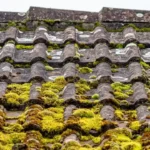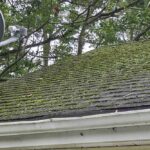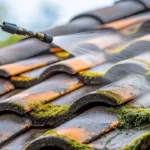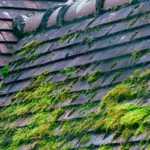Homeowners often find themselves dealing with the persistent issue of roof moss. While it might seem like a minor problem, roof moss safety concerns should not be overlooked. In this article, we’ll delve into the potential hazards that moss can pose to your roof and home, and provide insight on how to address these concerns effectively.

The Basics of Roof Moss
Moss is a small, green, leafy plant that thrives in damp, shaded environments. It often finds its way onto rooftops, especially those made of materials like asphalt shingles or wooden shakes. Moss can retain moisture, leading to potential damage over time.
How Does Moss Affect Your Roof?
One of the main roof moss safety concerns is its ability to trap moisture against the roof surface. This can lead to a host of issues such as rot, leaks, and structural damage. As moss grows, it can lift shingles, allowing water to seep underneath and damage the underlying structure.
Understanding the Risks of Moss on Your Roof
1. Moisture Retention
Moss acts like a sponge, absorbing and retaining water. This constant moisture can lead to the deterioration of roofing materials, increasing the risk of leaks and water damage.
2. Increased Weight Load
As moss accumulates on your roof, it can add significant weight. This additional load may stress the roof structure, particularly in regions with heavy snowfall.
3. Structural Damage
The growth of moss can cause shingles to lift and curl, compromising the roof’s integrity. This can lead to leaks and further damage to the interior of the home.
4. Safety Hazards
Wet moss can create slippery surfaces, posing a risk to anyone walking on the roof for maintenance or repairs. This increases the likelihood of slips and falls.
Preventing Moss Growth
Regular Roof Inspections
Conducting regular roof inspections can help identify early signs of moss growth, allowing for prompt intervention. Consider hiring a professional to ensure a thorough evaluation.
Maintaining Roof Cleanliness
Keep your roof clean by removing debris such as leaves and branches that can trap moisture and encourage moss growth. Regular cleaning can help prevent the buildup of moss.
Improving Drainage
Ensure that your roof has proper drainage to prevent water from accumulating. Clean gutters regularly to facilitate the smooth flow of rainwater.
Effective Moss Removal Methods
Manual Removal
One of the simplest methods of moss removal is manual removal using a brush or scraper. This method is suitable for small, localized patches of moss.
Chemical Treatments
Chemical treatments can be effective in killing moss and preventing regrowth. However, it’s important to choose products that are safe for the roofing material and the environment.
Professional Roof Cleaning
For extensive moss growth, consider hiring a professional roof cleaning service. They have the expertise and equipment to safely remove moss without damaging the roof.
The Role of Professional Help
When to Call a Professional
If you’re unsure about the extent of moss damage or how to safely remove it, it’s best to call a professional. They can assess the situation and recommend the best course of action.
Benefits of Professional Services
Professional services offer several benefits, including expertise, safety, and efficiency. They can ensure that moss is effectively removed and provide advice on preventing future growth.

FAQs about Roof Moss
1. Can moss damage my roof?
Yes, moss can damage your roof by trapping moisture, causing shingles to lift, and increasing the risk of leaks and structural damage.
2. How can I prevent moss from growing on my roof?
Regular maintenance, such as cleaning debris, improving drainage, and conducting inspections, can help prevent moss growth.
3. Is it safe to remove moss myself?
While it’s possible to remove small patches of moss yourself, extensive growth or difficult-to-reach areas may require professional help to ensure safety and prevent damage.
For more information on roof moss and its effects, you can visit this guide on removing moss from shingles. Additionally, explore the comprehensive insights on moss and leaks and the safety for pets on our website.
This article contains affiliate links. We may earn a commission at no extra cost to you.








